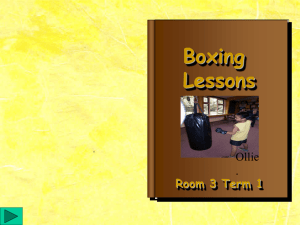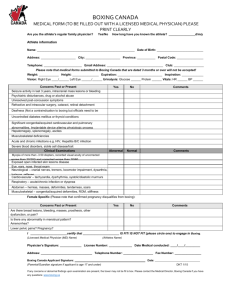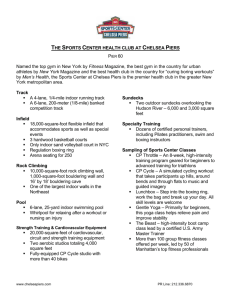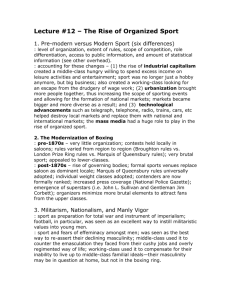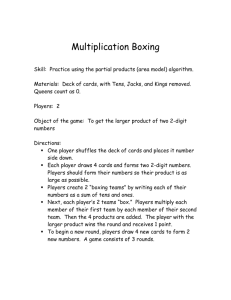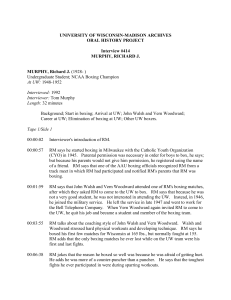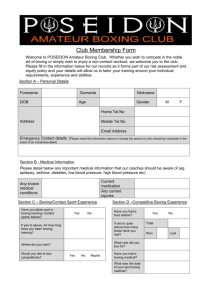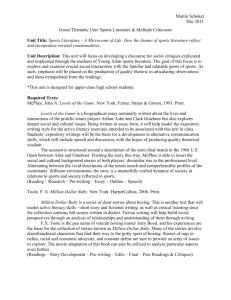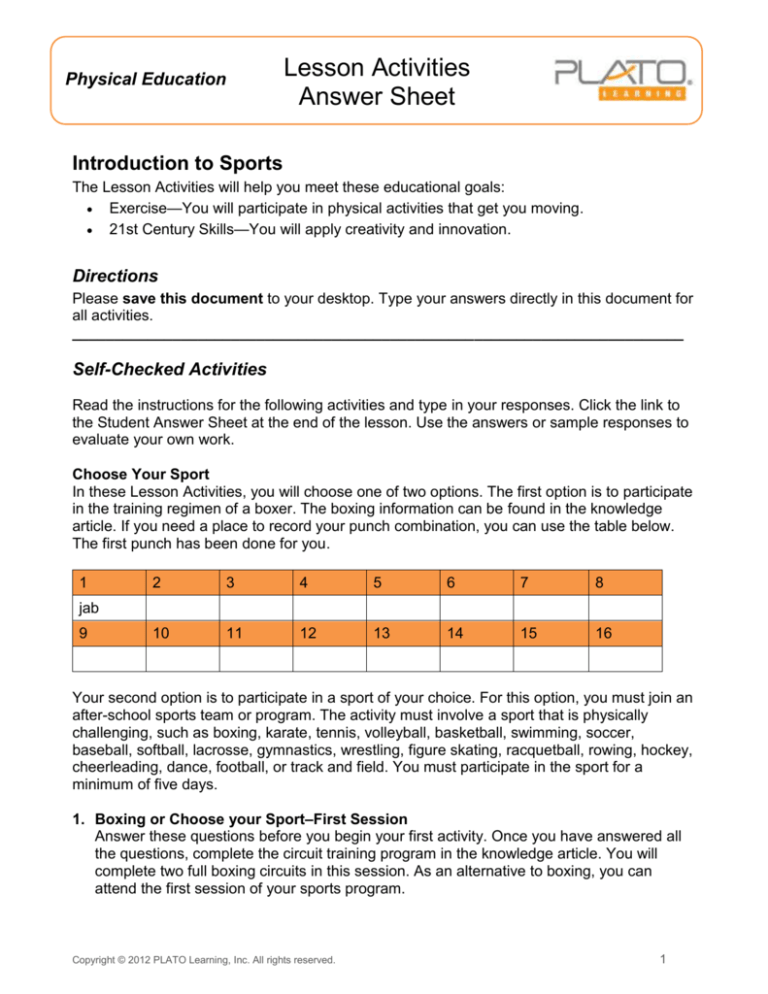
Physical Education
Lesson Activities
Answer Sheet
Introduction to Sports
The Lesson Activities will help you meet these educational goals:
Exercise—You will participate in physical activities that get you moving.
21st Century Skills—You will apply creativity and innovation.
Directions
Please save this document to your desktop. Type your answers directly in this document for
all activities.
_________________________________________________________________________
Self-Checked Activities
Read the instructions for the following activities and type in your responses. Click the link to
the Student Answer Sheet at the end of the lesson. Use the answers or sample responses to
evaluate your own work.
Choose Your Sport
In these Lesson Activities, you will choose one of two options. The first option is to participate
in the training regimen of a boxer. The boxing information can be found in the knowledge
article. If you need a place to record your punch combination, you can use the table below.
The first punch has been done for you.
1
2
3
4
5
6
7
8
10
11
12
13
14
15
16
jab
9
Your second option is to participate in a sport of your choice. For this option, you must join an
after-school sports team or program. The activity must involve a sport that is physically
challenging, such as boxing, karate, tennis, volleyball, basketball, swimming, soccer,
baseball, softball, lacrosse, gymnastics, wrestling, figure skating, racquetball, rowing, hockey,
cheerleading, dance, football, or track and field. You must participate in the sport for a
minimum of five days.
1. Boxing or Choose your Sport–First Session
Answer these questions before you begin your first activity. Once you have answered all
the questions, complete the circuit training program in the knowledge article. You will
complete two full boxing circuits in this session. As an alternative to boxing, you can
attend the first session of your sports program.
Copyright © 2012 PLATO Learning, Inc. All rights reserved.
1
a. Which option did you choose? Boxing? A different sport? Why did you choose it?
Sample answer:
I chose to do the boxing training activity because I don’t know anything about the
sport. I think it looks interesting. I hope to pick up some basic boxing skills, but I also
see it as an opportunity to build muscle.
b. What do you hope to learn from participating in the activity you selected?
Sample answer:
I hope to learn the basic moves and stances of boxing. I understand that I won't be
boxing with another person, but that’s OK. These exercises seem like a good starting
point. I really want to understand how to put together combinations. I’ve seen
professional boxers throw combinations on TV, but their hands move so quickly that I
can’t catch the finer details of the sport. Maybe this will be an opportunity for me to find
out more.
c. Do you foresee anything holding you back from completing this activity?
Sample answer:
I’m concerned whether I will have the stamina that it takes to box. I often see boxers
getting very tired after only a few rounds of boxing. I think I’ll need to improve my
fitness levels before I can build my boxing skills.
d. Do you have any goals for completing this activity? If so, what are they? If not, try to
think of at least one goal that you could try to achieve.
Sample answer:
My goal for the activity is to adopt the training methods boxers use. I work out
regularly, but I've been doing the same exercises for a long time. I want to learn some
new exercises that I haven't done before and try to master them as best I can. I want
to build my endurance level by at least 50 percent. If I'm able to cope with these
exercises, I might even consider joining a boxing club.
e. Is there any aspect of this activity that concerns you? If so, what is it?
Sample answer:
My parents are concerned that boxing is a violent sport and that I should perform a
different sport for this activity. But I told them there is no physical contact in these
exercises, not even with a punching bag. That’s actually one of my concerns. I’m
concerned that I won’t really understand the mechanics of the punches if I don’t get to
hit a bag of some kind.
2. Boxing or Choose your Sport–Second Session
Complete the circuit training program in the knowledge article. You will complete three full
boxing circuits in this session. As an alternative to boxing, you can attend the second
session of your sports program.
2
a. Compare how you felt after the second workout with how you felt after the first
workout. Were you more energized or tired? Did you experience any soreness or
muscle pain?
Sample answer:
I was more energized in the second boxing session than the first. I did the exercises
without any major problems, but I still have a long way to go. My shoulders are sore
from throwing so many punches, but they’re not painful.
b. What was your favorite part of the workout and why?
Sample answer:
My favorite part of the boxing workout was shadowboxing. There’s just something fun
about throwing punches in the air when you know that you won’t get hit. I felt like I was
getting pretty accurate with my punches. Without the shadowboxing, I’m not sure that
I’d like the activity that much.
c. What was your least favorite part of the workout and why?
Sample answer:
My least favorite part of the workout was the jump rope exercise. I’ve never been good
at jump rope. Most people think jump rope is for little kids, but it’s really a serious
cardio workout. After struggling for a few minutes with the rope, I had to give it up and
do the jumping jacks instead.
d. You are learning specific sports skills during your workouts. Do you think these skills
can transfer to other sports? If so, which sports? If not, why not?
Sample answer:
The circuit training program was specific to boxing, since it made use of boxing
punches. But the jump rope, push-ups, crunches, warm-up, and stretches can all be
used in different sports. I feel that a cardio exercise like jumping rope is basic enough
to be used in almost every sport that requires a high level of physical fitness. The
push-ups and crunches can be used in training for sports that demand greater upper
body strength, like tennis or baseball.
e. Did you warm up, cool down, and stretch before and after the workout? Why or why
not?
Sample answer:
I warmed up and stretched before the workout, because I know this can lower my
chance of injury. The stretches keep me from getting stiff muscles, especially when the
number of circuits goes up. I did the cooldown for about five minutes. I walked around
outside for a few minutes as part of the cooldown
3
3. Boxing or Choose Your Sport–Third Session
Complete the circuit training program in the knowledge article. You will complete four full
boxing circuits in this session. As an alternative to boxing, you can attend the third
session of your sports program.
a. Was this workout any easier than the workout in the second session? Why or why not?
Sample answer:
In some ways, the boxing workout was easier. I worked on what I learned from the last
two sessions, and was better prepared to do the exercises. I don’t seem to need as
much rest between circuits. This time, I ran in place instead of jumping rope. That
makes my workout easier. I sometimes forget the punching order, so I just improvise
as if I’m in a real match.
b. Compare how you felt after the third workout with how you felt after the second
workout. Were you more energized or tired? Did you experience any soreness or
muscle pain?
Sample answer:
During the third boxing circuit, I almost felt as if I couldn’t continue. But I pushed
through the crunches and just kept going. I got a second wind. I don’t remember that
happening in the second workout. When the workout was over, I felt quite good. I still
have some stiffness in my shoulders, but no pain.
c. If you participated in the team sport or activity, were your teammates helpful and
supportive? If you participated in the boxing circuit, have you established any kind of
support system? If so, who is it?
Sample answer:
I don’t know if he’s a support system, but my friend was at the gym with me when I
completed the boxing circuits. He didn’t do the warm-up or the stretching with me, but
he did shadowbox while facing me. We didn’t make any contact of course, but the
workout was a lot more fun having him around.
d. How long did it take you to complete your third workout? Where did your workout take
place?
Sample answer:
The session, including the breaks, warm-up, and cooldown, took me about an hour to
finish. I worked out next to the weight room at school. There are mats where the
wrestling team practices, but their season is over so the room was empty.
e. If you performed this workout every day, do you believe it would improve your level of
fitness? Could it impact your life in a positive way? Why or why not?
Sample answer:
I think if I did this every day, I would see improvements to my cardio and flexibility.
Right now, my high school is hosting football tryouts. I’ve always wanted to see what
4
football is like, but worry about making the cut. I talk about it, but never do it. Keeping
up with a regular workout could give me the confidence to try out for the team.
4. Boxing or Choose Your Sport–Fourth Session
Complete the circuit training program in the knowledge article. You will complete five full
boxing circuits in this session. As an alternative to boxing, you can attend the fourth
session of your sports program.
a. People of all ages play sports. Think about the sport you just participated in. Who
would you recommend this sport to? How old are they? Why might age be a
consideration for this kind of sport?
Sample answer:
In general, I’d recommend boxing to someone who’s between 18 and 30. The boxing
workout can be done by anyone since there is no contact. But I think that when striking
is involved in a real match, the person should be an adult. They can’t be too old,
because they would lose some of their quickness, so I listed an upper limit of 30 years.
b. What do you believe it takes to achieve in this sport? Explain. Consider using one or
all of these ideas: physical fitness, mental fitness, strategy, and diet.
Sample answer:
In boxing, you must have the best cardio and flexibility possible. I think boxing requires
more speed than strength. If you had a real opponent, your mind would have to be
sharp. For example, if you got hit, you’d have to ignore it and try to stay focused on
your strategy. That would not be easy to do. Nobody likes getting hurt. I think boxers
need to have good planning skills and be able to improvise if their plans don’t work. A
boxer needs to eat right and at the right times. During my own workout, I knew that I
did not leave enough time between eating and exercising because my stomach
sometimes felt queasy. This could hurt a boxer’s performance.
c. Describe the offense and the defense in the sport that you chose. What tactics are
used on offense or defense? What is the goal of each?
Sample answer:
In boxing, offense is throwing punches and moving around. The goal is to gain points
by striking. On defense, I suspect the goal is blocking punches so you don’t get hit in
the head or the body. To do well on offense, you’d have to throw punches fast and
hard, trying to find holes in the other person’s defense. To do well on defense, you’d
have to move around a lot, duck, and keep your hands up.
d. What forms does sportsmanship take in the sport that you’ve chosen? Give one or
more examples.
Sample answer:
In boxing, sportsmanship would be throwing punches in the approved areas. You can’t
hit the back of the head, for example. It would be bumping gloves before and after a
5
match. Sportsmanship would be congratulating the other person whether you win or
lose. Maybe you’d help them up off the ground if they fell down. It could also mean
listening to the referee and following all directions.
e. Which sports are similar to the sport that you’ve chosen? How are the sports similar?
How are they different?
Sample answer:
Boxing is similar to any one-on-one sport where opponents go head to head. I think it’s
like wrestling, karate, and mixed martial arts. The sports are similar in that they require
one opponent to overtake another. They are different in how that is accomplished. For
example, karate and mixed martial arts are about striking. But wrestling is about
putting someone in a hold without hitting them. Boxing and wrestling have been
around for a long time. I think karate has too.
5. Boxing or Choose Your Sport–Fifth Session
a. For this session, participate in a completely different sport. For example, if you have
been playing basketball, play volleyball or soccer instead. If you’ve been doing the
circuit training program in the knowledge article, design a new boxing circuit. Come up
with a new punch combination for shadowboxing and enter it into the table below.
Change the supplemental exercises in the circuit too. For example, instead of jumping
rope, push-ups, and crunches, you might choose to jog on a treadmill, lift weights, or
do sit-ups. You may vary the time of each exercise if you wish. Place the new
exercises for your circuit in the table. Once the table is filled out, incorporate it into the
circuit training program in the knowledge article and perform the circuit training
program. You can choose to do between two and five circuits.
Sample answer:
Shadowbox
4 minutes
1
2
Boxing Circuit
3
4
5
6
7
8
jab
jab
hook
uppercut
jab
jab
jab
cross
9
10
11
12
13
14
15
16
cross
uppercut
jab
jab
uppercut
jab
jab
Stationary Cycling
3 minutes
image (optional)
Bench Press
30 reps
image (optional)
Sit-Ups
2 minutes
image (optional)
hook
Boxing Circuit
directions (optional)
Boxing Circuit
directions (optional)
Boxing Circuit
directions (optional)
6
b. If you participated in a sport of your choice, which sport did you like better? If you
participated in boxing, which boxing circuit did you like better? Explain.
Sample answer:
I like the boxing circuit that I created for myself. Doing the same exercises repeatedly
can get boring. Variety is good. When I design the circuit myself, I tend to choose
equipment available to me. I designed bench press into my routine for some more
rigorous strength training.
c. Did changing the workout make your body feel any different? Explain.
Sample answer:
No, my body felt the same overall.
d. Are you going to continue with your sport of choice or with boxing training once this
activity is complete? Why or why not?
Sample answer:
Yes, I’m going to look more into boxing. I’d like to learn more about programs that are
out there. I think a tour of a gym would be good so I can see the equipment they use
and maybe even see a real match. Boxing is a sport that my parents are not crazy
about, but I just plan to gather information at first. I’m not even sure how much it costs.
e. Would you recommend this sport to others? Why or why not?
Sample answer:
I wouldn’t recommend boxing to everyone, as there are specific traits that you need to
be good at it. I would recommend it to people who are curious about it. I would also
recommend this sport to people who want to get rid of some stress and get a serious
upper body work out. I haven’t actually stepped into a boxing ring, and don’t plan on
doing so any time soon, but I learned that training to become a boxer is a challenge in
itself.
f. Did you learn any lessons from your sport that you can apply to your real life? Explain.
Sample answer:
In boxing, I learned to count on my second wind. When things got tough, I knew that
my adrenalin would kick in and I’d get through it. That can be applied to most things in
life. When it gets tough, you don’t fold, you just figure out a way to get around it.
7

